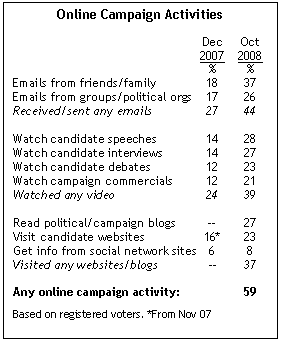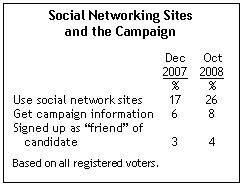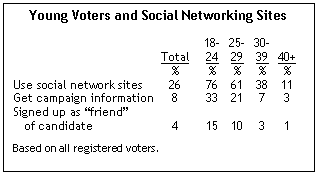
The internet is playing a large role in the current presidential campaign, both as a source of information for voters, as a means of communication between voters and political organizations, and among voters themselves. A solid majority of voters (59%) say they have sought out election content online or had some type of online communication about the campaign. Younger voters and Democrats are outpacing older voters and Republicans in using the internet for campaign information and activity. The use of online video has exploded, and significant numbers of voters have visited candidate websites and read blogs about the campaign. However, the use of social networking sites – such as MySpace or Facebook – for campaign information has not grown much since early in the campaign season.
Last December, just 18% of voters said they had exchanged emails about the campaign with friends or family; now 37% have done so. About a quarter of voters (26%) now say they have received an email from one of the political campaigns or from a political group or organization, up from 17% in December.

The proportion of voters who have gone online to view videos about the campaign has increased substantially since the start of the election season. Overall, 39% of voters say they have watched some type of campaign-related video online. In December, 24% had done so. There has been an increase in viewing of all types of campaign videos, including candidate speeches (28% now, up from 14%), interviews (27%, up from 14%), campaign commercials (21%, up from 12%), and candidate debates (23% now, 12% in December).
Nearly one-in-four voters (23%) have visited a candidate’s website; in November, just 16% had done this. And 27% have read blogs about politics and the campaign. But social networking sites remain a small part of the overall story about the internet and the campaign. Somewhat more voters now say they visit such sites (26% vs. 17% in December), but just 8% say they have visited a social networking site for campaign information, up two points since last year. Just 4% have signed up as a “friend” of a candidate (vs. 3% in December).
Partisan Differences in Campaign Web Use

There is little partisan difference in the use of email for the campaign, with roughly similar levels of Democrats, Republicans, and independents saying they have traded campaign-related emails with friends and family, or received emails from political groups. However, liberal Democrats far outpace other groups of partisans, including moderate and conservative Democrats, with 58% having traded emails with family and friends and 43% having received emails from political organizations.
Though the overall numbers are small, significantly more Democrats (12%) than Republicans (7%) or independents (5%) have gotten campaign information from social networking sites. All of these differences are driven by the behavior of liberal Democrats, 58% of whom have visited any websites or blogs about the campaign; by comparison, fewer than 40% of other partisan groups have done so (conservative and moderate Democrats at 35%, moderate and liberal Republicans at 37% and conservative Republicans at 32%).
Democrats also outpace Republicans in viewing video about the campaign, with 43% of Democrats – and 60% of liberal Democrats – saying they have seen at least some type of election-related video, compared with 35% of Republicans who have done this. Independents (at 41%) are more like Democrats in this respect. More Democrats than Republicans report viewing each type of online video asked about in the survey.
Young Voters and the Internet

Young voters, who use the internet more than older voters, are much more likely to use the net for certain kinds of political information and activity. Roughly half of voters in all age groups – except those ages 65 or older – have sent or received emails about the election. Among those ages 65 or older, only a quarter have sent or received campaign-related emails.
Nearly two-thirds of voters under age 30 (65%) have watched a campaign-related video online, and almost as many (59%) have read blogs, visited candidate websites, or used social networking sites. About half of young voters report having watched speeches (48%), interviews (47%) or the debates (47%) online; slightly fewer (36%) have watched campaign commercials on the web. More than one-third of older voters, including 41% of those ages 30 to 49 and 34% of those ages 50 to 64, have watched some type of video.
Political and campaign blogs have emerged as a popular internet destination for young voters, but significant minorities of older voters report reading them as well. Among those under age 30, 42% have visited blogs, as have 30% of voters ages 30 to 49 and 24% of Baby Boomers ages 50 to 64. About one-in-ten older voters (9%) have read political or campaign blogs.

Social networking sites were cited as sources of campaign information and activity by many young voters in December, as the primary season was heating up. But the use of such sites for political purposes does not appear to have grown very much since then.
Social networking sites remain a source of information for many of the youngest voters; a third of those ages 18-24 say they have gotten campaign information from such sites. Far smaller percentages of older voters have done this. Notably, the proportion of the youngest voters who have gotten campaign information from social networking sites has not increased since December; at that time, 37% of 18-24 year-olds said they received campaign information from such sites.


